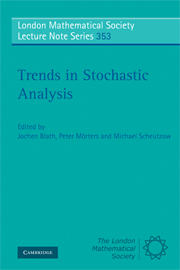Book contents
- Frontmatter
- Contents
- Preface
- Heinrich von Weizsäcker's students
- Heinrich von Weizsäcker's publications
- I Foundations and techniques in stochastic analysis
- II Construction, simulation, discretization of stochastic processes
- III Stochastic analysis in mathematical physics
- 8 Intermittency on catalysts
- 9 Stochastic dynamical systems in infinite dimensions
- 10 Feynman formulae for evolutionary equations
- 11 Deformation quantization in infinite dimensional analysis
- IV Stochastic analysis in mathematical biology
10 - Feynman formulae for evolutionary equations
Published online by Cambridge University Press: 05 March 2012
- Frontmatter
- Contents
- Preface
- Heinrich von Weizsäcker's students
- Heinrich von Weizsäcker's publications
- I Foundations and techniques in stochastic analysis
- II Construction, simulation, discretization of stochastic processes
- III Stochastic analysis in mathematical physics
- 8 Intermittency on catalysts
- 9 Stochastic dynamical systems in infinite dimensions
- 10 Feynman formulae for evolutionary equations
- 11 Deformation quantization in infinite dimensional analysis
- IV Stochastic analysis in mathematical biology
Summary
Abstract
The Feynman formula is a representation of the solution of an evolutionary equation by a limit of some multiple integrals over Cartesian products of the classical configuration space, or of the classical phase space, when the multiplicity of integrals tends to infinity. From the Feynman formula one can deduce the Feynman–Kac formula, i.e. a representation of the solution by an integral over trajectories. In this paper we consider representations, by the Feynman formula, of solutions both of some Schrödinger type equations and of the corresponding diffusion equations.
Introduction
The first of Feynman's papers [7], on what one now calls Feynman path integrals over trajectories in the configuration space, contains three main observations. Firstly, it is shown that the solution of the Cauchy problem for a Schrödinger equation can be represented by a limit of a sequence of integrals over Cartesian products of the classical configuration space when the multiplicity of integrals tends to infinity. Secondly, the limit is interpreted as an integral over trajectories in the configuration space. And finally, it is noticed that the integrand contains the exponent of the classical action. Feynman's definition of the Feynman path integrals over trajectories in the phase space, which is formulated in his second paper on the subject, has a similar structure but, in contrast to the preceding definition, the Lagrangian in the classical action is expressed through the Hamiltonian function.
- Type
- Chapter
- Information
- Trends in Stochastic Analysis , pp. 283 - 302Publisher: Cambridge University PressPrint publication year: 2009
- 9
- Cited by



